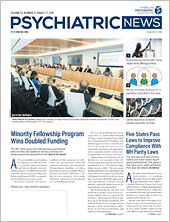A new suicide prevention model that has shown promise in Switzerland will be tested this September in the United States. The treatment is called Attempted Suicide Short Intervention Program (ASSIP). It will be implemented in Onondaga County, N.Y., as part of a statewide suicide prevention effort funded through a $3.5 million federal grant from the Substance Abuse and Mental Health Services Administration.
People who have attempted suicide are known to be the most likely to die by suicide. An estimated 1.3 million adults aged 18 or older attempted suicide in 2016, according to the National Institute of Mental Health.
ASSIP targets patients who have recently attempted suicide. It consists of three 60- to 90-minute face-to-face sessions followed by regular, personalized letters sent to patients over two years. Konrad Michel, M.D., a professor emeritus at the University Hospital of Psychiatry in Bern, and colleagues developed the program.
Michel coauthored a study in PLOS Medicine in March 2016 that showed that ASSIP was associated with an 80 percent reduction in repeat suicide attempts among 120 patients admitted to the emergency unit of the Bern University of General Hospital after a suicide attempt.
Half of the patients were randomly selected for treatment as usual, which included a single clinical interview in the emergency unit followed by a risk assessment summary that was sent to the patients’ outpatient providers. The other half received treatment as usual plus ASSIP. During the 24 months of follow-up, five repeat suicide attempts were recorded in the ASSIP group, and 41 repeat suicide attempts were recorded in the control group. One person died by suicide in each group.
For the first session, which is videotaped, a patient tells the therapist how he or she reached the point of wanting to die by suicide. In the second session, the patient and therapist review the tape together. In the final session, the therapist and patient identify signs that the patient may be feeling suicidal, as well as strategies the patient can use to stay safe. These are printed on a card that the patient carries at all times, along with a list of emergency numbers. Over the next two years, therapists send patients a series of personalized letters reminding them of the risk of experiencing a suicidal crisis and the importance of using safety strategies at those times.
Suicide has less to do with a patient’s psychiatric diagnoses and more to do with each patient’s inner experience and narrative, Michel told Psychiatric News. “The patient is in the expert position, which gives the patient insight into his or her own suicidal crisis.”
Michel said that the process allows patients to feel heard and understood, which creates trust—the basis of a strong therapeutic alliance. Creating that alliance is key to ASSIP’s patient-centered, collaborative approach.
The authors noted that if ASSIP achieves similar results in the United States, the program may one day become a common evidence-based follow-up treatment that could reduce the number of deaths by suicide.
“ASSIP fulfills the need for an easy-to-administer, low-cost intervention,” the authors concluded. ■
“A Novel Brief Therapy for Patients Who Attempt Suicide: A 24-Months Follow-Up Randomized Controlled Study of the Attempted Suicide Short Intervention Program (ASSIP)” can be accessed
here.

